I received an email via West Wolds U3A website alerting me to a coach tour organised by The National Churches Trust and entitled Explore the Explorers. The aim of the day was not just to admire and learn about these culturally important buildings and their architecture, but also to discover their rich heritage, hidden treasures and surprising connections with major events and people in British history. As this is something that greatly appeals to me, I thought I’d book a place.
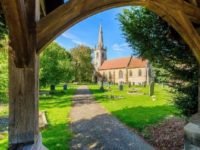 With over 40 attendees on the coach, the first church we visited was the Grade II listed St Lawrence’s in Revesby. Whilst walking round the church, we came across the Norman font, a reredos with gilded angels and mother of pearl inlay and saw where fragments of the original Revesby Abbey had been reset into the tower. Whilst enjoying cake and a cuppa, we listened to a talk given by Gavin Wiggins-Davis outlining the history of the Revesby Estate and its connection with the world renown botanist and naturalist Sir Joseph Banks whom he very aptly described as a cross between David Attenborough and the Dr Who of his time. Banks roamed the extensive Revesby estate as a young boy, and it was here he first developed his keen interest in collecting plants.
With over 40 attendees on the coach, the first church we visited was the Grade II listed St Lawrence’s in Revesby. Whilst walking round the church, we came across the Norman font, a reredos with gilded angels and mother of pearl inlay and saw where fragments of the original Revesby Abbey had been reset into the tower. Whilst enjoying cake and a cuppa, we listened to a talk given by Gavin Wiggins-Davis outlining the history of the Revesby Estate and its connection with the world renown botanist and naturalist Sir Joseph Banks whom he very aptly described as a cross between David Attenborough and the Dr Who of his time. Banks roamed the extensive Revesby estate as a young boy, and it was here he first developed his keen interest in collecting plants.
 The next church was St Benedict’s at Scrivelsby; this building originated in the 13th century however, it was completely restored in 1860 by Sir Henry Dymoke. Following our walk around the interior, Francis Dymoke delivered an entertaining talk about his family’s role as the King’s Champion. After the Norman Conquest, the Scrivelsby
The next church was St Benedict’s at Scrivelsby; this building originated in the 13th century however, it was completely restored in 1860 by Sir Henry Dymoke. Following our walk around the interior, Francis Dymoke delivered an entertaining talk about his family’s role as the King’s Champion. After the Norman Conquest, the Scrivelsby 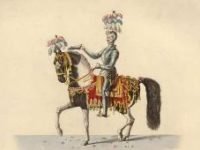 estate was given to Robert Marmion whose family had historically been Champions to the Dukes of Normandy; the role then passed to the Dymoke family who have held this feudal hereditary office ever since. The duty of the King’s Champion was to ride armed into the coronation banquet at Westminster Hall and challenge anyone who doubted the new monarch’s right
estate was given to Robert Marmion whose family had historically been Champions to the Dukes of Normandy; the role then passed to the Dymoke family who have held this feudal hereditary office ever since. The duty of the King’s Champion was to ride armed into the coronation banquet at Westminster Hall and challenge anyone who doubted the new monarch’s right 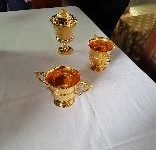 to the throne by throwing down his gauntlet three times. If no challenge was made, in tribute to the Champion, the king drank from a gold cup and then gave the cup to his Champion. We were able to view three of these lovely cups as sadly, the others have been lost over time.
to the throne by throwing down his gauntlet three times. If no challenge was made, in tribute to the Champion, the king drank from a gold cup and then gave the cup to his Champion. We were able to view three of these lovely cups as sadly, the others have been lost over time.
Our third church was that of St Mary’s in Horncastle which 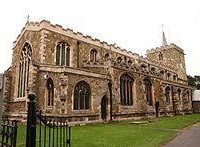 dates from the 12th century and is Grade II listed. Here we enjoyed a delightful afternoon tea and a talk by Paul Scott who spoke in more depth about the life of Sir Joseph Banks who, remains to this day, one of the most important figures both in the history of science and that of Great Britain. Banks took part in Captain James Cook‘s first great voyage and is credited for
dates from the 12th century and is Grade II listed. Here we enjoyed a delightful afternoon tea and a talk by Paul Scott who spoke in more depth about the life of Sir Joseph Banks who, remains to this day, one of the most important figures both in the history of science and that of Great Britain. Banks took part in Captain James Cook‘s first great voyage and is credited for  bringing 30,000 plant specimens home with him of which he personally discovered 1,400. In addition, Banks held the position of President of the Royal Society, advised King George III, founded Kew Gardens, advocated British settlement in New South Wales and the colonisation of Australia and established Botany Bay as a place for the reception of convicts.
bringing 30,000 plant specimens home with him of which he personally discovered 1,400. In addition, Banks held the position of President of the Royal Society, advised King George III, founded Kew Gardens, advocated British settlement in New South Wales and the colonisation of Australia and established Botany Bay as a place for the reception of convicts.
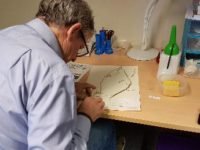 The Sir Joseph Banks Society was formed in 2006 in order to promote his life and achievements; it is based at the Sir Joseph Banks Centre in Horncastle where visitors can enjoy the reference library, research room, gift shop and tribute garden which contains 70 species of plants found during his voyage on HMS Endeavour. To help foster a better understanding of plants and the environment and inspire a new generation of botanists, we were able to visit the new herbarium and watch the state-of-the-art imaging technology being used alongside volunteers manually mounting and storing of some of the 9,000 plant specimens.
The Sir Joseph Banks Society was formed in 2006 in order to promote his life and achievements; it is based at the Sir Joseph Banks Centre in Horncastle where visitors can enjoy the reference library, research room, gift shop and tribute garden which contains 70 species of plants found during his voyage on HMS Endeavour. To help foster a better understanding of plants and the environment and inspire a new generation of botanists, we were able to visit the new herbarium and watch the state-of-the-art imaging technology being used alongside volunteers manually mounting and storing of some of the 9,000 plant specimens.
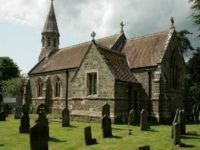 The fourth and last church on our tour was St Margaret’s at Thimbleby. This building is Victorian however, it is thought to have replaced an earlier Georgian church which had superseded a medieval structure. Despite its apparent ‘youth’, the church faced closure due to its stonework disintegrating but, it has since undergone extensive repairs to the tower which has now been made safe. In addition to
The fourth and last church on our tour was St Margaret’s at Thimbleby. This building is Victorian however, it is thought to have replaced an earlier Georgian church which had superseded a medieval structure. Despite its apparent ‘youth’, the church faced closure due to its stonework disintegrating but, it has since undergone extensive repairs to the tower which has now been made safe. In addition to 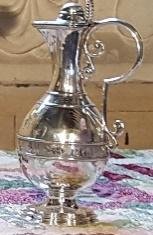 inspecting the new and old parts of the building, we were also able to see its magnificent 16th century silver chalice, reputedly given to the church by Mary Tudor, Queen of England for the village’s support in the Lincolnshire Rising.
inspecting the new and old parts of the building, we were also able to see its magnificent 16th century silver chalice, reputedly given to the church by Mary Tudor, Queen of England for the village’s support in the Lincolnshire Rising.
From the church, we walked a short distance to admire and look round one of several very attractive and old thatched cottages. They are especially significant because they were built using the ‘mud and stud’ 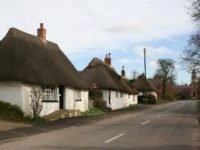 method of construction which is almost exclusive to this part of Lincolnshire. It has been confirmed that the same method was used to build the houses in the first permanent English settlement in Jamestown, Virginia because, the builders arrived in a ship led by Lincolnshire born (Willoughby) local hero Captain John Smith. Not
method of construction which is almost exclusive to this part of Lincolnshire. It has been confirmed that the same method was used to build the houses in the first permanent English settlement in Jamestown, Virginia because, the builders arrived in a ship led by Lincolnshire born (Willoughby) local hero Captain John Smith. Not  only was Smith a leader of the Virginia Colony based at Jamestown, but he also became the first English explorer to map the Chesapeake Bay area and the coast of New England.
only was Smith a leader of the Virginia Colony based at Jamestown, but he also became the first English explorer to map the Chesapeake Bay area and the coast of New England.
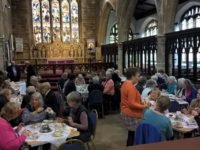 And so our day finally came to an end. It had been a most interesting and educational journey through our beautiful Lincolnshire countryside, stopping off to look round four delightful churches and hearing stories which connected them to people and moments of much note in British history. Everywhere we went we were greeted enthusiastically, listened to fascinating speakers and enjoyed the finest of Lincolnshire fayre and I for one, will be eagerly looking out for the next outing to be arranged by Linda Patrick who is the Church Support Officer for the National Churches Trust. – Nadia Dawson
And so our day finally came to an end. It had been a most interesting and educational journey through our beautiful Lincolnshire countryside, stopping off to look round four delightful churches and hearing stories which connected them to people and moments of much note in British history. Everywhere we went we were greeted enthusiastically, listened to fascinating speakers and enjoyed the finest of Lincolnshire fayre and I for one, will be eagerly looking out for the next outing to be arranged by Linda Patrick who is the Church Support Officer for the National Churches Trust. – Nadia Dawson

Leave a Reply
You must be logged in to post a comment.